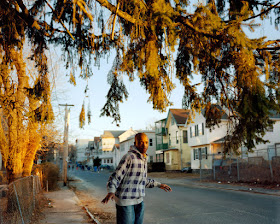The Blog about Fine Art Photography in the American South
"In the South they are convinced that they are capable of having bloodied their land with history. In the West we lack this conviction."
-- Joan Didion
Tuesday, November 17, 2015
Blake Andrews on Fashions in Fine Art Photography Today
Blake Andrews is an Oregon-based photographer who has some interesting things to say about the state of fine art photography today on his blog, here.
I bring this up for us because many of the examples Andrews gives are of photography projects made in the American South.
If you read this, and he's taking about you, you will know who you are:
Andrews writes:
"Male photographer ventures through a region with a camera, sometimes over the course of several months or years, in search of Americana.
"The American West is a common target. Or the South. Or the North. Or Appalachia. Or whatever, so long as it has a mix of salt-of-the-earth types willing to stare broodingly into middle distance, forested vistas, access to an airport, and a strong whiff of pathos.
"Maybe the photographer lives with the locals, or frequents their watering hole, or whatever it takes to develop access. Photographer returns home with a carefully calibrated mix of landscapes, portraits, and interiors shot on color film.
"Usually the tool is a view camera, although a smaller body is allowed so long as it's a Mamiya 7. The inkjet results are printed nice and big, mounted in the squared white frame du jour, no matting, with slightly desaturated color palette to match, then sent off on the exhibition circuit, where they present a statement about the place.
"Or about America. Or a nostalgic nod to the industrial cycle. Or something."
Andrews calls this style doctrinicity, which he characterizes by its use of a "landscape/interior/portrait combination" in forming a sequence of images, achieving a "photo two-fer, a way of expressing inner ruminations under the guise of outer world documentation."
Work in this style, Andrews believes, reveals the photographer taking "on the role of scientific explorer. Go out, trap some images, report findings to the photo community in the prescribed mix."
The establishment of a style also suggests the creation of a prescription for doing this work -- a shot list, if you will, of images one must take, regardless of the setting, location, or situation.
Andrews says that this approach to fine art photography can result in excellent work, not just a set of do-overs of other people's shots.
Andrews' example of effective use of this approach is the work of Brooklyn-based photographer Thomas Gardiner (see images above, all of which could have been made in the American South, but probably weren't).
Andrews blames the popularity of this approach in fine art photography to the success of of Alex Soth's Sleeping by the Mississippi, although one could think of a significant number of other predecessors, both for some of Gardiner's images and for the general quasi-documentary approach he takes to his subjects.
Working from formulas is not necessarily a bad thing -- witness the beloved sonnets of Shakespeare, which repeat over and over forms, ideas, and verbal images well-known from the works of Petrarch and his followers.
On the other hand, formulaic approaches to image-making call for subtlety, wit, creativity, and discipline to keep from becoming repetitive and boring.
Your thoughts?





This is super John, thanks for posting it. I think I noticed this trend really becoming dominant with the advent of digital, even though as Blacke points out, view cameras are often involved. My observation was that after looking at photo blogs/tumblr etc. I am no longer able to tell who photographed what by simply looking at the photo.
ReplyDeleteWhen I became pretty deeply immersed in photography, before digital, it seemed I could tell a Sally Mann from Deborah Turbeville, or Mary Ellen Mark, or Dorothy Lang photo at a glance. Now I find that impossible. To me this point is underscored by the photos Blake has on his blog illustrating his post.
I think his words on spot on. The conclusion, which I take to be facetious, is a bit odd. Nevertheless, I have noticed and fallen victim to this trend. I'm currently trying to shake it, but I also think doing something new just because it's new isn't always the answer. Chasing trends is always troubling, but unlike some other recent photographic trends, this one entails a great deal of time and effort. Thanks for posting this.
ReplyDelete